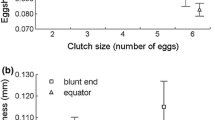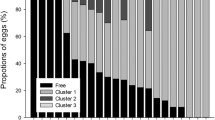Abstract
We compared membrane thickness of fully developed eggs with those of non-developed eggs in different endangered falcon taxa. To our knowledge, membrane thickness variation during development has never been examined before in falcons or any other wild bird. Yet, the egg membrane constitutes an important protective barrier for the developing embryo. Because eggshell thinning is a general process that occurs during bird development, caused by calcium uptake by the embryo, eggs are expected to be less protected and vulnerable to breakage near the end of development. Thus, egg membranes could play an important protective role in the later stages of development by getting relatively thicker. We used linear mixed models to explore the variation in membrane thickness (n = 378 eggs) in relation to developmental stage, taxon, female age, mass and identity (73 females), egg-laying sequence (105 clutches) and the study zone. Our results are consistent with the prediction that egg membranes are thicker in fully developed eggs than in non-developed eggs, suggesting that the increase in membrane thickness during development may compensate for eggshell thinning. In addition, our data shown that thicker membranes are associated with larger, heavier and relatively wider eggs, as well as with eggs that had thinner eggshells. Egg-laying sequence, female age and the study zone did not explain the observed variation of membrane thickness in the falcon taxa studied. As we provide quantitative data on membrane thickness variation during development in falcons not subjected to contamination or food limitation (i.e. bred under captive conditions), our data may be used as a reference for studies on eggs from natural populations. Considering the large variation in membrane thickness and the multiple factors affecting on it and its importance in the protection of the embryo, we encourage other researchers to include measurements on membranes in studies exploring eggshell thickness variation.





Similar content being viewed by others
References
Ahlborn G, Sheldon BW (2005) Enzymatic and microbiological inhibitory activity in eggshell membranes as influenced by layer strains and age and storage variables. Poult Sci 84:1935–1941
Ar A, Rahn H, Paganelly CV (1979) The avian egg: mass and strength. Condor 81:331–337
Bennett RS (1995) Relative sensitivity of several measures of eggshell quality to the stage of embryonic development. Bull Environ Contam Toxicol 54:428–431
Blom J, Lilja C (2004) A comparative study of growth, skeletal development and eggshell composition in some species of birds. J Zool 262:361–369
Bunck CM, Spann JV, Pattee OH, Fleming WJ (1985) Changes in eggshell thickness during incubation: implications for evaluating the impact of organochlorine contaminants on productivity. Bull Environ Contam Toxicol 35:173–182
Burnham WA, Enderson JH, Boardman TJ (1984) Variation in peregrine falcon eggs. Auk 101:578–583
Cade TJ, Lincer JL, White CM, Roseneau DG, Swartz LG (1971) DDE residues and eggshell changes in Alaskan falcons and hawks. Science 172:955–957
Castilla AM, Herrel A, Díaz G, Francesca A (2007) Developmental stage affects eggshell breaking strength in two ground-nesting birds: the partridge (Alectoris rufa) and the quail (Coturnix japonica). J Exp Zool 307A:471–477
Castilla AM, Martínez de Aragón J, Herrel A, Møller S (2009a) Eggshell thickness variation in Red-legged Partridge (Alectoris rufa) from Spain. Wilson J Ornithol 121:167–170
Castilla AM, Herrel A, Van Dongen S, Furio N, Negro JJ (2009b) Determinants of egg shell strength in endangered raptors. J Exp Zool 311A:303–311
Castilla AM, Herrel A, Robles H, Malone J, Negro JJ (2010) The effect of developmental stage on eggshell thickness variation in endangered falcon species. Zoology (in press)
Chao MR, Hsien CH, Yeh CM, Chou SJ, Chu C, Su YC, Yu CY (2007) Assessing the prevalence of Salmonella enterica in poultry hatcheries by using hatched eggshell membranes. Poult Sci 86:1651–1655
Cobb GP, Bargar TA, Pepper CB, Norman DM, Houlis PD, Anderson TA (2003) Using chorioallantoic membranes for non-lethal assessment of persistent organic pollutant exposure and effect in oviparous wildlife. Ecotoxicology 12:31–45
Cramp S, Simmons KEL (1980) Handbook of the birds of Europe, the Middle East and North of Africa: the birds of the Western Palearctic Volume II. Oxford University Press, Oxford
Ecay TW, Stewart JR, Blackburn DG (2004) Expression of calbindin-D-28K by yolk sac and chorioallantoic membranes of the corn snake, Elaphe guttata. J Exp Zool B Mol Dev Evol 302B:517–525
Elaroussi MA, Deluca HF (1994) Calcium-uptake by chorioallantoic membrane effects of vitamins D and K. Am J Physiol Endocrinol Metab 30:837–841
Falk K, Møller S (1990) Clutch size effects on eggshell thickness in the Peregrine Falcon and European Kestrel. Ornis Scand 21:265–269
Falk K, Møller S, Mattox W (2006) A long-term increase in eggshell thickness of Greenlandic Peregrine Falcons Falco peregrinus tundrius. Sci Total Environ 355:127–134
Feberwee A, de Wit JJ, Landman WJM (2009) Induction of eggshell apex abnormalities by Mycoplasma synoviae: field and experimental studies. Avian Pathol 38:77–85
Felsenstein J (1985) Phylogenies and the comparative method. Am Nat 125:1–15
Felsenstein J (2008) Comparative methods with sampling error and within-species variation: contrasts revisited and revised. Am Nat 171:713–725
Fernie KJ, Shutt L, Letcher RJ, Ritchie IJ, Bird DM (2009) Environmentally relevant concentrations of DE-71 and HBCD alter eggshell thickness and reproductive success of American kestrels. Environ Sci Technol 43:2124–2130
Gosler AG, Higham JP, Reynolds J (2005) Why are birds' eggs speckled? Ecol Lett 8:1105–1113
Jagannath A, Shore RF, Walker LA, Ferns PN, Gosler AG (2008) Eggshell pigmentation indicates pesticide contamination. J Appl Ecol 45:133–140
Kamata R, Takahashi S, Shimizu A, Shiraishi F (2006) Avian transgenerational reproductive toxicity test with in ovo exposure. Arch Toxicol 80:846–856
Karlsson O, Clas Lilja C (2008) Eggshell structure, mode of development and growth rate in birds. Zoology 111:494–502. doi:10.1016/j.zool.2007.11.005
Kutchai H, Steen JB (1971) Permeability of the shell and shell membranes of hens' eggs during development. Respir Phyiol 11:265–278
Mao KM, Murakami A, Iwasawa A, Yoshizaki N (2007) The asymmetry of avian egg-shape: an adaptation for reproduction on dry land. J Anat 210:741–748
Miller MM, Ealey KA, Oswald WB, Schat KA (2003) Detection of chicken anemia virus DNA in embryonal tissues and eggshell membranes. Avian Dis 47:662–671
Oppel S, Powell AN, O'Brien DM (2009) Using eggshell membranes as a non-invasive tool to investigate the source of nutrients in avian eggs. J Ornithol 150:109–115
Peakall DB, Lincer JL (1996) Do PCBs cause eggshell thinning? Environ Pollut 91:127–129
Peakall DB, Lew TS, Springer AM, Walker WW, Riscbrough RW, Monk JG, Jarman WM, Walton BJ, Reynolds LM, Fyfe RW, Kiff LF (1983) Determination of DDE and PCB contents of peregrine falcon eggs: a comparison of whole egg measurements and estimates derived from eggshell membranes. Arch Environ Contam Toxicol 12:523–528
Pearce JM, Fields RL, Scribner KT (1997) Nest materials as a source of genetic data for avian ecological studies. J Field Ornithol 68:471–481
Pepper CB, Rainwater TR, Platt SG, Dever JA, Anderson TA, McMurry ST (2004) Organochlorine pesticides in chorioallantoic membranes of Morelet's crocodile eggs from Belize. J Wildl Dis 40:493–500
Rahbek C (1993) Captive breeding—a useful tool in the preservation of biodiversity. Biodivers Conserv 2:426–437
Rahn H, Ar A (1974) The avian egg: incubation time, water loss and nest humidity. Condor 76:147–152
Romanoff AL, Romanoff AJ (1949) Biochemistry of the avian embryo. Wiley, New York
Solomon SE (1991) Egg and eggshell quality. Wolfe Publishing, Aylesbury
Tuan RS, Ono T, Akins RE, Koide M (1991) Experimental studies on cultured, shell-less fowl embryos: calcium transport, skeletal development, and cardio-vascular functions. In: Deeming DC, Ferguson MWJ (eds) Egg incubation: its effect on embryonic development in birds and reptiles. Cambridge University Press, Cambridge, pp 419–433
Tucker GM, Heath MF (1994) Birds in Europe: their conservation status, BirdLife Conservation Series 3. BirdLife International, Cambridge
Vanderstoep J, Richards JF (1970) The changes in eggshell strength during incubation. Poult Sci 49:276–285
Wegner P, Kleinstäuber G, Baum F, Schilling F (2005) Long-term investigation of the degree of exposure of German peregrine falcons (Falco peregrinus) to damaging chemicals from the environment. J Ornithol 146:34–54
Wilkin TA, Gosler AG, Garant D, Reynolds SJ, Sheldon BC (2009) Calcium effects on life-history traits in a wild population of the great tit (Parus major): analysis of long-term data at several spatial scales. Oecologia 159:463–472
Yoshizaki N, Saito H (2002) Changes in shell membranes during development of quail embryos. Poult Sci 81:246–251
Acknowledgements
We would like to acknowledge the persons in charge and the workers of Roc Falcon especially Harald Kuespert, Stania Kuespert, Oscar Oliva Piferrer and Sandor Sebestyen for providing detailed information about the falcons, for helping to collect the eggs and measuring the birds. We thank Andy Gosler, Sven Thatje, Hugo Robles and one anonymous referee for constructive comments. We also thank to Benno Böer (UNESCO Office Doha, Qatar) for his support and encouragement to improve our knowledge about the biology and conservation of endangered falcons. This work was conducted on a contract of the Spanish National Research Council (Agencia Estatal Consejo Superior de Investigaciones Científicas, CSIC; to AMC), the logistic support of the Ayuntamiento de Sanaüja and the Project MICIIN-CGL 2009-10652 (BOS).
Author information
Authors and Affiliations
Corresponding author
Rights and permissions
About this article
Cite this article
Castilla, A.M., Van Dongen, S., Herrel, A. et al. Increase in membrane thickness during development compensates for eggshell thinning due to calcium uptake by the embryo in falcons. Naturwissenschaften 97, 143–151 (2010). https://doi.org/10.1007/s00114-009-0620-z
Received:
Revised:
Accepted:
Published:
Issue Date:
DOI: https://doi.org/10.1007/s00114-009-0620-z




